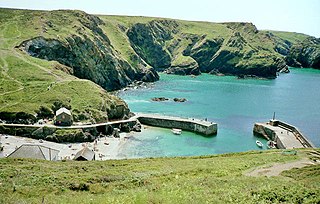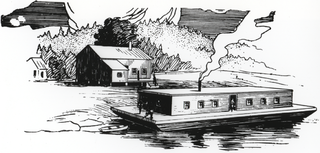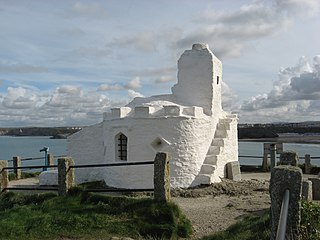
Bantry is a town in the civil parish of Kilmocomoge in the barony of Bantry on the coast of West Cork, County Cork, Ireland. It lies at the head of Bantry Bay, a deep-water gulf extending for 30 km (19 mi) to the west. The Beara Peninsula is to the northwest, with Sheep's Head peninsula to the southwest.

Gillnetting is a fishing method that uses gillnets: vertical panels of netting that hang from a line with regularly spaced floaters that hold the line on the surface of the water. The floats are sometimes called "corks" and the line with corks is generally referred to as a "cork line." The line along the bottom of the panels is generally weighted. Traditionally this line has been weighted with lead and may be referred to as "lead line." A gillnet is normally set in a straight line. Gillnets can be characterized by mesh size, as well as colour and type of filament from which they are made. Fish may be caught by gillnets in three ways:
- Wedged – held by the mesh around the body.
- Gilled – held by mesh slipping behind the opercula.
- Tangled – held by teeth, spines, maxillaries, or other protrusions without the body penetrating the mesh.

Bantry Bay is a bay located in County Cork, Ireland. The bay runs approximately 35 km (22 mi) from northeast to southwest into the Atlantic Ocean. It is approximately 3-to-4 km wide at the head and 10 km (6.2 mi) wide at the entrance.

Seine fishing is a method of fishing that employs a fishing net, called a seine, that hangs vertically in the water with its bottom edge held down by weights and its top edge buoyed by floats. Seine nets can be deployed from the shore as a beach seine, or from a boat.

Whiddy Island is an island near the head of Bantry Bay, Ireland. It is approximately 5.6 km (3.5 mi) long and 2.4 km (1.5 mi) wide. The topography comprises gently-rolling glacial till, with relatively fertile soil. As late as 1880 the island had a resident population of around 450, mainly engaged in fishing and small-scale farming, but today the population has reduced to approximately 20 people. Previously home to Whiddy Island Naval Air Station the island is noted for its oil terminal facilities – and the related Whiddy Island Disaster.

Cadgwith is a village and fishing port in Cornwall, England, United Kingdom. It is on the Lizard Peninsula between The Lizard and Coverack. It is in the civil parish of Grade Ruan.
The Scottish east coast fishery has been in existence for more than a thousand years, spanning the Viking Age right up to the present day.

Mullion Cove or Porth Mellin is a small community on the west coast of the Lizard Peninsula in Cornwall, England. It is on the eastern side of the Mount's Bay. The Cove forms part of the parish of Mullion, and is accessible by road from Mullion village, 1 mile (1.6 km) away to the north east, and also by the popular South West coast path. It lies within an Area of Outstanding Natural Beauty

In English fishing customs, a conder, also called a huer or bulker, was a person who stood on high places near the sea coast in times of herring-fishing to signal to the fishers which way the shoal of herrings or pilchards passed—their course being more discernible to those who stand on high cliffs, due to the blue colour they cause in the water, than to those aboard vessels. In Cornwall, huers helped locate shoals of fish. The huer would shout 'Hevva!, Hevva!' to alert the boats to the location of the pilchard shoals.
Heavy cake or Hevva cake is a cake made from flour, lard, butter, milk, sugar and raisins that originated in Cornwall.

Gurnard's Head is a prominent headland on the north coast of the Penwith peninsula in Cornwall, England, UK. The name is supposed to reflect the fact that the rocky peninsula resembles the head of the gurnard fish.

The fishing industry in Scotland comprises a significant proportion of the United Kingdom fishing industry. A recent inquiry by the Royal Society of Edinburgh found fishing to be of much greater social, economic and cultural importance to Scotland than it is relative to the rest of the UK. Scotland has just 8.4 per cent of the UK population but lands at its ports over 60 per cent of the total catch in the UK.

A fishing vessel is a boat or ship used to catch fish in the sea, or on a lake or river. Many different kinds of vessels are used in commercial, artisanal and recreational fishing.

A factory ship, also known as a fish processing vessel, is a large ocean-going vessel with extensive on-board facilities for processing and freezing caught fish or whales. Modern factory ships are automated and enlarged versions of the earlier whalers and their use for fishing has grown dramatically. Some factory ships are equipped to serve as a mother ship.

Commercial fishing is a major industry in Alaska, and has been for hundreds of years. Alaska Natives have been harvesting salmon and many other types of fish for millennia. Russians came to Alaska to harvest its abundance of sealife, as well as Japanese and other Asian cultures.
This page is a list of fishing topics.
The following outline is provided as an overview of and topical guide to fishing:

Fishing in Cornwall, England, UK, has traditionally been one of the main elements of the economy of the county. Pilchard fishing and processing was a thriving industry in Cornwall from around 1750 to around 1880, after which it went into an almost terminal decline. During the 20th century the varieties of fish taken became much more diverse and crustaceans such as crab and lobster are now significant. Much of the catch is exported to France due to the higher prices obtainable there. Though fishing has been significantly damaged by overfishing, the Southwest Handline Fishermen's Association has started to revive the fishing industry. As of 2007, stocks are improving. The Cornwall Sea Fisheries Committee is one of 12 such committees responsible for managing the corresponding Sea Fisheries District. The Isles of Scilly Sea Fisheries Committee is responsible for the Scilly district.

A salmon cannery is a factory that commercially cans salmon. It is a fish-processing industry that became established on the Pacific coast of North America during the 19th century, and subsequently expanded to other parts of the world that had easy access to salmon.

The Huer's Hut is a listed building in Newquay, Cornwall, England. It may date from the 14th century and have originally seen use as a hermitage and lighthouse. By the 16th century it was used as a lookout point for the seasonal arrival of pilchards in the bay. A man known as a huer would signal the arrival of the pilchards and direct fishermen towards them. The structure was in the ownership of Cornwall Council and was subject to restoration work in 2014. It is now on a lifelong lease to Newquay Town Council.


















